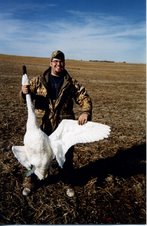
Whoever said that youth is wasted on the young, never attended the Minnesota Waterfowl Association’s Woodie Camp. I returned as a counselor again this year for the second year in a row. It was another great experience for me as a waterfowl hunter and a person. I attended the camp as a youngster and cherish the memories that are triggered from that experience.
Hunting has allowed me to make many friends and hunt in many different places. The least I feel that I can do is give something back to the sport. I feel that if I am not here for the younger generations of waterfowl hunters, then who is?
There are many different aspects of waterfowl hunting that are taught at the Minnesota Waterfowl Association’s Woodie Camp. Each one of these topics serves a purpose; helping to mold young hunter’s aged 13 to 15, into educated waterfowl enthusiasts.
It would be harder to rate the specific topics of the Minnesota Waterfowl Association’s Woodie Camp on a scale, than it would be to discuss them in any detail. If I were to discuss all of the aspects of the many topics I would certainly fill all of the pages within this publication. With that said, I will discuss only a few.
With 70% of all ducks being produced in the prairie-pothole region of North America, it is hard to ignore habitat. Luckily, the camp is held at the Prairie Wetlands Learning Center or PWLC, in Fergus Falls, Minnesota were there is plenty of prairie for the campers to study under the guidance of educated instructors.
Instructors walk with the campers along prairie trials and discuss different aspects of the prairie while they are in the field, so to speak. Campers learn about different prairie plants, their root structures, and why the different plants are important.
They also learn about the drastic decline of the prairie. The grasslands of North America are just as vital to our Ecosystem as the rain forest. The grasses produce valuable oxygen and actually contain more types of life forms. Still you don’t see ‘Save the Prairie’ bumper stickers plastered on cars.
Not only do ducks face habitat decline, many different predators also target them. The predator that kills the most ducks on the prairie is the Red Fox. It is important to remember that roughly 87% of all ducks never make it off the nest, because of the abundance of predators.
Campers are taught how to build nesting structures for waterfowl, and the importance of them. Mallard ‘hen houses’ are designed to keep the female ducks elevated and away from predators. Wood duck ‘boxes’ are used by female Wood ducks in the place of tree cavities.
Bird banding has been one of the many highlights of Woodie Camp since the camp started. Band data allows biologists to track the life spans of waterfowl and the migration patterns of waterfowl. The bands help to insure the future of hunting through this data, and provide a souvenir for waterfowl hunters.
There have been approximately 300 ducks banded by the Minnesota Waterfowl Association’s Woodie Camp attendees since 2003. Since then hunters have harvested 22 of those banded ducks and 1 was found dead. These bands were recovered in 8 different states: Minnesota, Missouri, Louisiana, Wisconsin, Arkansas, Oklahoma, Texas and Alabama. 5 of the 23 ducks were Mallards and 18 were Wood ducks.
The Minnesota Waterfowl Association’s Woodie Camp runs for 1 week, from Sunday to Saturday. Like any summer camp, it starts slow and finishes fast. Even after my third year at camp I am impressed by the amount of information that can be taught about waterfowl hunting in one week.
As hunters it is important for us to share our passion for the outdoors with others. Edmund Burke has been given credit for saying, “Tell me what are the prevailing sentiments that occupy the minds of our young men, and I will tell you what is to be the character of the next generation.”

1 comment:
Woodie Camp---I do it for the kids.
Post a Comment